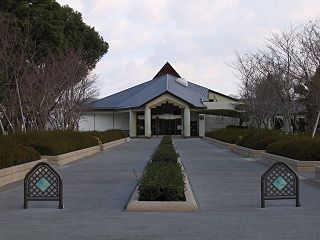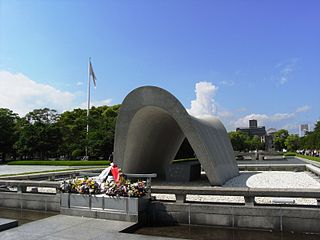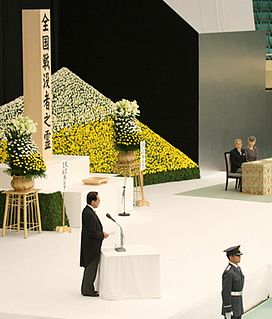 W
WBansei Tokkō Peace Museum is a war museum in Minamisatsuma, Kagoshima Prefecture. Opened in 1993, the museum commemorates the 201 airmen from the Bansei Air Base (万世飛行場) who died in a kamikaze attack in the final months of the Pacific War. Hichiro Naemura, a flight instructor at the Bansei base in 1945, spearheaded the effort to establish this institution as a memorial to his fallen comrades.
 W
WThe airbase at Chiran, Minamikyūshū, on the Satsuma Peninsula of Kagoshima, Japan, served as the departure point for hundreds of Special Attack or kamikaze sorties launched in the final months of World War II. A peace museum dedicated to the pilots, the Chiran Peace Museum for Kamikaze Pilots , now marks the site.
 W
WThe Cornerstone of Peace is a monument in Itoman commemorating the Battle of Okinawa and the role of Okinawa during World War II. The names of over two hundred and forty thousand people who lost their lives are inscribed on the memorial.
 W
WThe Hiroshima Peace Memorial , originally the Hiroshima Prefectural Industrial Promotion Hall, and now commonly called the Genbaku Dome, Atomic Bomb Dome or A-Bomb Dome , is part of the Hiroshima Peace Memorial Park in Hiroshima, Japan and was designated a UNESCO World Heritage Site in 1996. The ruin of the hall serves as a memorial to the over 140,000 people who were killed in the atomic bombing of Hiroshima on 6 August 1945.
 W
WHiroshima Peace Memorial Park is a memorial park in the center of Hiroshima, Japan. It is dedicated to the legacy of Hiroshima as the first city in the world to suffer a nuclear attack, and to the memories of the bomb's direct and indirect victims. The Hiroshima Peace Memorial Park is visited by more than one million people each year. The park is there in memory of the victims of the nuclear attack on August 6, 1945, in which the United States dropped an atomic bomb on the Japanese city of Hiroshima. The Hiroshima Peace Memorial Park was planned and designed by the Japanese Architect Kenzō Tange at Tange Lab.
 W
WKaiten Memorial Museum is a museum on the island of Ōzushima in the Inland Sea, in Shūnan, Yamaguchi Prefecture, Japan, dedicated to the history and memory of the Kaiten, a Special Attack Unit of the Imperial Japanese Navy. The museum first opened near the remains of the island's training base in 1968, reopening in today's building in 1998. The collection of some one thousand items includes wills, letters, uniforms, personal belongings, and photographs. The displays combine these exhibits with information panels on the background and history of the unit and the lives of those served in it. The museum is "a facility for learning about Peace through the minds and hearts of the Kaiten".
 W
WThe Monument to Commemorate Chinese Victims of the Atomic Bombing is in Nagasaki Peace Park in Nagasaki, Japan. During WWII, at least 40,000 Chinese laborers were forcibly brought to Japan from China to make up for a nationwide labor shortage. There were about 1,000 Chinese laborers forced to work in mines in Nagasaki. During the atomic bomb on Nagasaki, 32 of those Chinese laborers died.
 W
WThe National Memorial Service for War Dead is an official, secular ceremony conducted annually on August 15, by the Japanese government at the Nippon Budokan in Tokyo, Japan. The ceremony is held to commemorate the victims of World War II. The first memorial ceremony was held on May 2, 1952.
 W
WThe Ryōzen Kannon (霊山観音) is a war memorial commemorating the War dead of the Pacific War located in Eastern Kyoto. The concrete and steel statue of the Bodhisattva Avalokiteśvara (Kannon) was built by Hirosuke Ishikawa and unveiled on 8 June 1955. The statue is 24 m (80 ft) high and weighs approximately 500 tons.
 W
WYasukuni Shrine is a Shinto shrine located in Chiyoda, Tokyo. It was founded by Emperor Meiji in June 1869 and commemorates those who died in service of Japan from the Boshin War of 1868–1869 through the First Indochina War of 1946–1954. The shrine's purpose has been expanded over the years to include those who died in the wars involving Japan spanning from the entire Meiji and Taishō periods, and the lesser part of the Shōwa period.